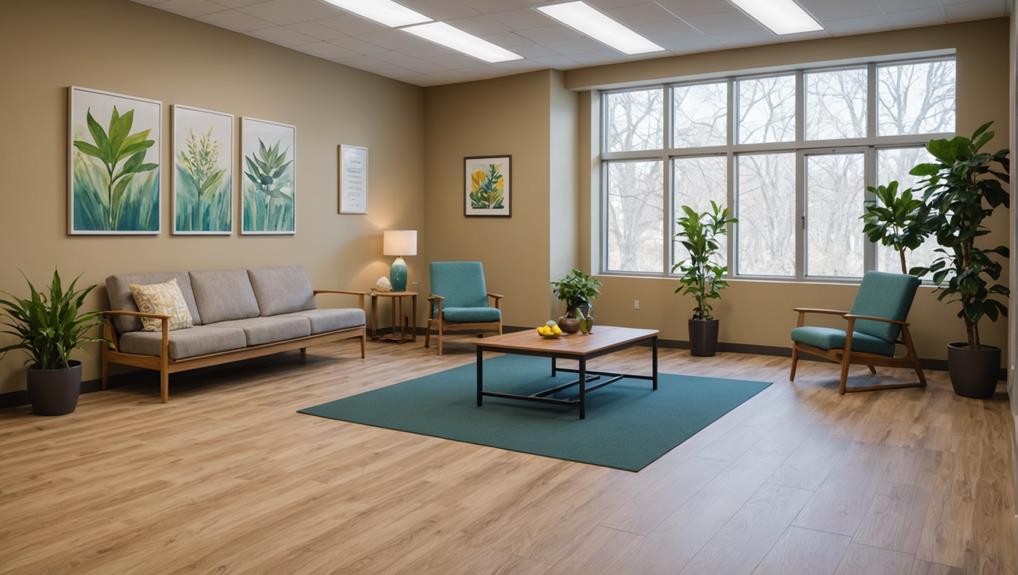When you choose low-impact flooring for rehabilitation rooms, you're prioritizing safety, comfort, and sustainability. Look for materials that minimize slips and provide cushioned surfaces to ease strain on joints. Options like cork, rubber, and eco-friendly vinyl not only enhance aesthetics but also promote healing and mobility. Durable and easy to maintain, these surfaces can withstand heavy foot traffic while reducing noise, creating an inviting atmosphere. Invest in quality flooring to guarantee long-term benefits for both patients and caregivers. There's much more to discover about how the right flooring can transform rehabilitation environments into spaces of healing and comfort.
Importance of Low-Impact Flooring
When you think about flooring, it's easy to overlook how much impact it has on your home and the environment. Low-impact flooring plays an essential role, especially in spaces dedicated to rehabilitation and recovery. Imagine a surface that not only supports patient mobility but also provides a safe haven for those in need of assistance. The right flooring can greatly reduce the risk of slips and falls, which is crucial in environments where patients are regaining strength and stability.
Durability is another key factor to take into account. Low-impact flooring materials are designed to withstand heavy foot traffic and frequent cleaning, ensuring they maintain their integrity over time. You want a surface that can endure the wear and tear of rehabilitation activities while remaining comfortable underfoot for both patients and caregivers. This durability means fewer replacements, leading to less waste and a reduced environmental footprint.
Moreover, choosing low-impact flooring shows a commitment to sustainability. Many options available today are made from eco-friendly materials that contribute to a healthier living space. You're not just making a choice for aesthetics; you're investing in a product that supports the well-being of your patients and the planet.
Key Features to Consider
In the quest for the perfect low-impact flooring, you'll want to keep a few key features at the forefront of your decision-making. First and foremost, consider safety. Look for flooring that provides excellent traction to minimize slips and falls, especially in rehabilitation settings where individuals may be unsteady on their feet. A cushioned surface can also help absorb impact, reducing strain on joints and encouraging mobility.
Next, think about durability. Your flooring should withstand heavy foot traffic and resist wear and tear over time. High-quality materials will not only last longer but also save you from frequent replacements, which can be both costly and disruptive.
Sustainability options are increasingly important, too. Choosing eco-friendly materials not only benefits the environment but also contributes to a healthier indoor air quality, an essential factor in rehabilitation spaces. Opt for flooring made from renewable resources or recycled products to enhance your facility's green credentials.
Don't overlook aesthetic choices, as a visually appealing environment can promote healing and comfort. Whether you prefer warm wood tones or vibrant colors, select a flooring style that complements the overall design of your rehabilitation rooms.
Types of Low-Impact Flooring
Finding the right type of low-impact flooring can transform a space into a safe and inviting environment. When considering options, you'll want to focus on materials that reduce the risk of slips while providing comfort underfoot. Here's a quick look at some popular choices:
| Flooring Type | Pros | Cons |
|---|---|---|
| Cork Flooring | Soft, eco-friendly, warm | Can be susceptible to moisture |
| Rubber Tiles | Durable, slip-resistant | Can be heavy and expensive |
| Bamboo Options | Sustainable, stylish | May scratch easily |
| Vinyl Alternatives | Water-resistant, affordable | Can emit VOCs |
| Linoleum Types | Easy to clean, durable | Limited design choices |
| Carpet Squares | Comfortable, sound-absorbing | Can trap allergens |
| Foam Mats | Lightweight, versatile | Less durable for heavy use |
Each of these low-impact flooring options can enhance the safety and comfort of rehabilitation rooms. For example, cork flooring provides a cushiony feel, while rubber tiles offer unparalleled slip resistance. If you're looking for an eco-friendly choice, consider bamboo options, which not only look great but are sustainable too.
Vinyl alternatives and linoleum types are excellent for their ease of maintenance, making them practical for high-traffic areas. Carpet squares provide a cozy feel, perfect for creating a warm atmosphere. Ultimately, foam mats can be easily rearranged, adding versatility. By choosing the right flooring, you'll create a nurturing space that prioritizes safety and comfort.
Benefits for Patients
When you step onto low-impact flooring, you'll instantly feel the difference in comfort and safety, providing a more supportive environment for patients. The cushioning effect not only reduces strain on joints but also helps minimize the risk of slips and falls. Plus, with noise reduction benefits, the soothing atmosphere enhances focus and relaxation, making recovery a smoother journey.
Enhanced Comfort and Safety
Low-impact flooring can transform a healthcare environment into a haven of comfort and safety for patients. Imagine stepping onto a surface that feels soft yet supportive underfoot, designed with ergonomic principles that cater to your needs. This type of flooring not only cushions your feet but also considerably enhances patient mobility. You'll find it easier to move around, whether you're walking, using a walker, or maneuvering a wheelchair.
Safety is paramount in rehabilitation spaces, and low-impact flooring excels in providing a slip-resistant surface. You can feel confident knowing that the chance of falls is minimized, allowing you to focus on your recovery rather than worrying about accidents. The flooring's shock-absorbing qualities help reduce the strain on your joints, making every step a little less intimidating.
Additionally, the smooth, continuous surface reduces the risk of tripping hazards, creating an environment where you can move more freely and safely. With low-impact flooring, you're not just getting a functional surface; you're investing in your well-being. This thoughtful choice prioritizes your comfort and safety, making every moment in your rehabilitation journey more pleasant.
Noise Reduction Benefits
Imagine stepping into a healing space where the chatter of bustling activity fades into a soothing background hum. In rehabilitation rooms, effective noise reduction isn't just a luxury; it's vital for patient well-being. Low-impact flooring with acoustic insulation and sound absorption properties can transform the environment, promoting tranquility and focus.
Here are some key benefits of noise reduction for patients:
- Enhanced Relaxation: A quieter space helps reduce stress and anxiety, allowing for better recovery.
- Improved Concentration: Patients can concentrate on therapy sessions, leading to more effective outcomes.
- Better Sleep Quality: A serene environment fosters restful sleep, important for healing.
- Reduced Pain Perception: Lower noise levels can diminish the perception of pain, promoting comfort.
- Increased Privacy: Sound absorption materials guarantee that personal conversations remain confidential, fostering a sense of safety.
Benefits for Healthcare Providers
Numerous benefits await healthcare providers who choose low-impact flooring for their facilities. First and foremost, the safety of both patients and staff is enhanced. Low-impact flooring often features slip-resistant surfaces, considerably reducing the risk of falls—a critical concern in rehabilitation settings. This attention to safety not only protects individuals but also fosters an environment where both care providers and patients feel secure.
Moreover, low-impact flooring contributes to patient engagement by creating inviting and therapeutic environments. The aesthetics of your facility are essential to encouraging patients to participate actively in their rehabilitation. By selecting flooring that's comfortable underfoot and visually appealing, you're more likely to inspire patients to move around and engage with their surroundings, promoting a positive mindset essential for recovery.
Additionally, the durability of low-impact flooring means you'll spend less time and resources on replacements and repairs. This long-term investment translates to lower costs over time, allowing you to allocate funds towards other important services or innovations in patient care.
Lastly, low-impact floors can also help reduce noise levels, creating a calm atmosphere that aids in the healing process. Enhanced acoustics support patient comfort and focus, ensuring that each moment spent in your facility is as peaceful as possible. By embracing low-impact flooring, you're not just improving your space; you're elevating the entire patient experience, which ultimately reflects positively on your healthcare practice.
Maintenance and Care Tips
Keeping your low-impact flooring in top shape is easier than you might think. By establishing a regular cleaning schedule and mastering stain removal techniques, you can enhance its longevity and appearance. Plus, a few preventive maintenance practices can go a long way in preserving that fresh look and feel.
Regular Cleaning Schedule
Establishing a regular cleaning schedule is essential for maintaining the beauty and longevity of your low-impact flooring. Keeping your floors clean not only enhances their appearance but also guarantees a safe environment for rehabilitation. You'll want to determine a cleaning frequency that suits your space while considering foot traffic and specific needs of the occupants.
Here are some tips to guide your cleaning routine:
- Daily Sweeping: Remove dust and debris to prevent scratches.
- Weekly Mopping: Use gentle cleaning products to avoid damaging the surface.
- Spot Cleaning: Attend to spills immediately to prevent stains and accidents.
- Monthly Deep Cleaning: Consider a thorough cleaning with appropriate solutions for deeper dirt removal.
- Regular Inspections: Check for wear and tear, addressing any issues promptly to maintain safety.
Stain Removal Techniques
Even with a diligent cleaning routine, accidents can happen, and stains may find their way onto your low-impact flooring. Knowing how to tackle various stain types effectively will keep your space looking fresh and inviting. Here are some common stains and appropriate cleaning solutions to take into account:
| Stain Types | Cleaning Solutions |
|---|---|
| Food and Beverages | Mix warm water with mild dish soap. |
| Ink | Dab with rubbing alcohol on a cloth. |
| Grease | Use a solution of vinegar and water. |
| Mud | Let it dry, then vacuum and wipe with a damp cloth. |
| Pet Accidents | Clean with an enzymatic cleaner. |
Always remember to test any cleaning solution on a small, inconspicuous area first to verify it won't damage your flooring. Blot the stain gently, rather than scrubbing, to avoid spreading it further. With these simple stain removal techniques, you can maintain a safe and clean environment for everyone in your rehabilitation room, making sure that your low-impact flooring continues to look its best.
Preventive Maintenance Practices
A well-maintained floor can transform the atmosphere of any space, providing both beauty and functionality. To guarantee your low-impact flooring remains in top condition, adopting preventive maintenance practices is essential. Regular maintenance not only enhances the aesthetic appeal but also contributes to flooring longevity and safety. Here are some tips to keep in mind:
- Conduct preventive inspections: Regularly check for signs of wear, damage, or moisture to catch issues early.
- Use appropriate cleaning products: Avoid harsh chemicals that can damage the flooring surface. Opt for mild, floor-safe cleaners.
- Implement a cleaning schedule: Consistency is key; create a routine for sweeping, mopping, and deep cleaning to prevent dirt buildup.
- Address spills promptly: Wipe up any spills immediately to prevent stains and slipping hazards, promoting a safer environment.
- Consider protective mats: Place mats in high-traffic areas to reduce wear and tear, which can prolong the life of your flooring.
Cost Considerations
When it comes to flooring, cost considerations play a crucial role in your decision-making process. You'll need to approach this with careful budget planning, ensuring that your choices align with both safety and financial constraints. Every dollar counts, especially when you're outfitting rehabilitation rooms where patients deserve the best care in the safest environment.
Start by evaluating your budget and identifying how much you can allocate for flooring. Consider not just the initial costs of the material selection, but also long-term expenses like maintenance and durability. Low-impact flooring options, like cork or rubber, may have a higher upfront cost, but their longevity and ease of cleaning can save you money in the long run.
Don't forget to factor in potential savings on injury-related costs. Flooring that minimizes slips and falls can reduce the risk of accidents, leading to fewer claims and a safer space for everyone. It's crucial to choose materials that not only fit your budget but also contribute to a secure environment.
Research various suppliers and compare prices, as discounts or bulk purchasing can greatly affect your overall expenditure. Some flooring manufacturers offer warranties that may make their products more appealing, despite higher initial costs. Ultimately, the goal is to strike a balance between cost and quality, ensuring that your flooring choice supports both safety and rehabilitation needs while staying within your financial limits.
Installation Best Practices
After you've settled on the right flooring options and budget, the next step is guaranteeing a successful installation. Choosing the right installation techniques is just as vital as selecting safe flooring materials. A well-executed installation not only enhances the aesthetic appeal of rehabilitation rooms but also guarantees safety and longevity.
To help you navigate this process, here are some best practices for installing low-impact flooring:
- Prepare the Subfloor: Confirm that the subfloor is clean, dry, and level. Any imperfections can impact the flooring's performance and safety.
- Acclimate Flooring Materials: Let your flooring materials acclimate to the room's temperature and humidity for at least 48 hours before installation. This helps prevent warping or buckling later on.
- Use Appropriate Adhesives: Choose adhesives that are compatible with your flooring materials and safe for indoor environments. This minimizes off-gassing and promotes better air quality.
- Follow Manufacturer Guidelines: Always adhere to the installation instructions provided by the manufacturer. This guarantees that you're using the recommended techniques, which can protect your warranty.
- Consider Professional Help: If you're unsure about the installation process, hiring a professional can assure a safe and effective outcome.
Case Studies and Examples
In exploring the impact of low-impact flooring, real-world case studies illustrate how thoughtful choices can transform spaces while prioritizing safety and sustainability. Take the example of a rehabilitation center that recently renovated its therapy rooms. They opted for cork flooring, celebrated for its shock-absorbing qualities. Patients reported markedly improved experiences during therapy sessions, feeling more secure and comfortable when moving around. The soft surface reduced strain on their joints, allowing them to focus on recovery rather than discomfort.
Another notable case involved a hospital that implemented vinyl flooring innovations. By choosing a high-performance vinyl with anti-slip properties, they addressed safety concerns head-on. Staff noticed a marked decrease in slip-and-fall incidents, which not only improved patient safety but also reduced liability risks. Patients felt more at ease, knowing the environment was designed with their well-being in mind.
In both instances, the flooring choices didn't just enhance aesthetics—they fundamentally improved patient experiences. The centers also reported lower maintenance costs, as the durable materials stood up to daily use while remaining easy to clean.
These examples highlight how strategic flooring decisions can lead to safer, more inviting rehabilitation spaces. By prioritizing low-impact options, you're not only investing in the physical environment but also uplifting the overall experience for patients. Your choices can create a foundation that supports healing and fosters confidence in every step taken.
Frequently Asked Questions
What Are the Most Eco-Friendly Low-Impact Flooring Options Available?
Imagine walking on a cloud, feeling that soft, cushioned support beneath your feet. For eco-friendly low-impact flooring, consider options like cork or bamboo, which use sustainable materials. These choices not only provide comfort but also embrace green living. Look for installation methods that minimize waste, like click-lock systems, ensuring safety and ease. With the right flooring, you can create a safe, stylish space while treading lightly on our planet.
How Does Low-Impact Flooring Affect Indoor Air Quality?
When you consider low-impact flooring, you're also thinking about how it affects indoor air quality. These materials can greatly reduce airborne pollutants and VOC emissions, creating a healthier environment for everyone. By opting for options like cork or bamboo, you're not just choosing comfort; you're prioritizing safety. In spaces where air quality is essential, selecting flooring that minimizes harmful substances can lead to a more breathable and pleasant atmosphere.
Can Low-Impact Flooring Help Prevent Slips and Falls?
Absolutely, low-impact flooring can greatly help with slip resistance and fall prevention. When you choose flooring designed with textured surfaces or specific materials, it enhances grip, reducing the chances of slips. This is especially important in areas where safety's a top priority. By investing in flooring that prioritizes both comfort and safety, you're creating an environment that minimizes risks, ensuring that everyone can move with confidence and peace of mind.
What Is the Lifespan of Different Low-Impact Flooring Materials?
Choosing flooring is like picking a sturdy tree for your yard—some last longer than others. Vinyl's durability can offer up to 20 years, making it a wise choice for high-traffic areas. On the other hand, cork's resilience provides about 10 to 20 years, depending on maintenance. Both options can guarantee safety and comfort, but understanding their lifespans helps you make an informed decision, assuring you've got a reliable foundation for years to come.
Are There Any Certifications for Low-Impact Flooring Products?
When you're looking for low-impact flooring, it's crucial to take into account certification standards that guarantee safety and quality. Many products undergo rigorous testing, so you can trust their performance. As you make product comparisons, look for certifications like FloorScore or GreenGuard, which indicate low emissions and overall safety. These certifications help you choose flooring that not only meets your needs but also contributes to a healthier environment for everyone.




